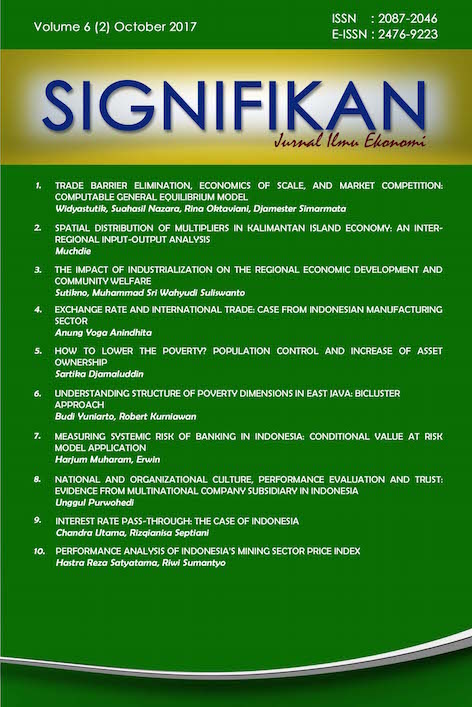Trade Barrier Elimination, Economics of Scale and Market Competition: Computable General Equilibrium Model
DOI:
https://doi.org/10.15408/sjie.v6i2.5279Keywords:
trade barrier, economics of scale, market competition, gravity modelAbstract
The ASEAN and its dialogue partner countries agreed to reduce trade barriers in the services sector, one of which is sea transport services. The purpose of this study is to estimate the equivalent tax of non-tariff barriers in the sea transport services. Besides that, this study is going to analyze the economic impacts of the regulatory barriers elimination in the sea transport services of ASEAN and its dialogue partner countries. Using the gravity model, it can be identified that trade barriers of sea transport services sector of ASEAN and dialogue partner countries are still relatively high. Additionally, by adopting IC-IRTS model in Global CGE Model (GTAP), the simulation results show consistent results with the theory of pro-competitive effects. The greater gain from trade is obtained in the CGE model assuming IC-IRTS compared to PC-CRTS. China gains a greater benefit that is indicated by the highest increase in welfare and GDP followed by Japan and Australia
References
Anderson, J.E. & E.V. Wincop. (2001). Gravity with Gravitas: A Solution to the Border Puzzle. NBER Working Paper No.8079.
Callaghan, B., A. & U. Uprasen. (2008). Impact of the 5th EU Enlargement on ASEAN. Euro-Asia Centre (EAC), Working Paper. Ireland: Kemmy Business School University of Limerick, Ireland.
Dee, P., K. Hanslow. & T. Phamduc. (2003). Measuring the cost of barriers to trade in services, in Ito, T. and Krueger, A. (eds), Services Trade in the Asia-Pacific Region. NBER-East Asia Seminar on Economics, Volume 11, University of Chicago Press, Chicago, pp. 11–43.
De Melo, J. (1988). CGE Models for The Analysis of Trade Policy in Developing Countries. Policy Research Working Paper Series 3, The World Bank.
Elbehri, A., & T. Hertel. (2004). A Comparative Analysis of The EU-Morocco FTA vs Multilateral Liberalization. GTAP Working Paper No.30. Revised 2006. Center for Global Trade Analysis, Purdue University.
Francois, J.F. (1998). Scale Economies and Imperfect Competition in the GTAP Model. GTAP Technical Paper No. 14.
Francois, J. (2001). The Next WTO Round: North-South Stakes in New Market Access Negotiations. Adelaide: Centre for International Economic Studies.
Francois, J.F., dan D.W. Roland-Host. (1996). Trade Policy, Scale Economies and Imperfect Competition in Applied Model. Cambridge: Cambridge University Press.
Hayami, Y & Y. Godo. (2005). Development Economics. From the Poverty to The Wealth of Nations (3rd Ed). Oxford: Oxford University Press.
Hertel, T., K. Anderson., J. Francois. & W. Martin. (1999). Agriculture and Non-Agricultural Liberalisation in the Millennium Round. Paper presented at the Global Conference on Agriculture and the New Trade Agenda from a Development Perspective: Interests and Options in the WTO 2000 Negotiations, World Bank and WTO, Geneva, 1-2 October.
Isard, W. (1954). Location Theory and Trade Theory: Short-Run Analysis. Quarterly Journal of Economics, 68: 305-322.
Kalirajan, K. (2000). Restrictions on Trade in Distribution Services. Productivity Commissions Staff Research Paper. Canbera: Ausinfo.
Lejour, A.M., R.A. de Mooij. & R. Nahuis. (2001). EU: Enlargement: Economic Implication for Countries and Industries. CPB Document 11. CPB Netherland Bureau for Economic Policy Analysis.
Limao, N. & A.J. Venables. (1999). Infrastructure, Geographical, Disadvantage, and Transport Cost. Policy Research Working Paper. The World Bank Development Research Group Trade.
Matto, A., R.M. Stern., & G. Zanini. (2008). A Handbook of International Trade in Services. Oxford: Oxford University Press.
Pannenungi, M.A. (2004). Model CGE dengan Skala Ekonomi yang Meningkat dan Persaingan Tidak Sempurna: Aplikasi pada Studi Kawasan Perdagangan ASEAN-China (CGE Model With Increasing Economic of Scale and Incompetitive Market: Aplication in ASEAN-China Trade Are). (Unpublished Dissertation). Depok: Universitas Indonesia.
Park, S.C. (2002). Measuring Tariff Equivalent in Cross Border Trade in Services. KIEP Working Paper 02-15, Korea Institute for International Economic Policy.
Rose, A.K. (2002). Estimating Protectionism through Residuals from The Gravity Model. Working Paper. California: University of California Berkeley.
Sheperd, B. & E.V.D. Marrel. (2010). Trade in Services in The APEC Region: Pattern, Determinants, and Policy Implications. APEC Policy Support.
Stern, R. & B. Hoekman. (1988). The Service Sector in Economic Structure and in International Transactions. in L. Castle and C. Findlay (eds.), Pacific Trade in Services. Sydney: Allen & Unwin.
Tinbergen, J. (1962). Shaping the World Economy: Suggestion for an International Economic Policy. Appendix VI. New York: The Twentieth Century Fund.
Walsh, K. (2006). Trade in Services: Does Gravity Hold? A Gravity Model Approach to Estimating Barriers to Services. Institute for International Integration Studies (IIIS) Discussion Paper. No 183/October 2006.
Winchester, N. (2008). Is There Are Dirty Little Secret? Non Tariff Barriers and The Gain From Trade. Economics Discussion Papers. New Zealand: University of Otago.
Wong, M., H. & C.H. Hollweg. (2015). Regulatory Restrictions in Logistic Services of ASEAN+6 Economies in ASEAN and Regional Free Trade Agreements. Edited Christoper Findlay. Routledge-ERIA Studies in Development Economics. London: Taylor and Francis Group.
Yeah, K.L., J.F. Yanagida., & H. Yamauchi. (1994). Evaluation of External Market Effects and Government Intervention in Malaysia Agriculture Sector: A Computable General Equilibrium Framework. Agric, Econ. 11(2-3): 237-256.


